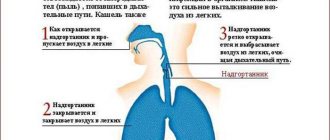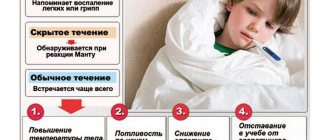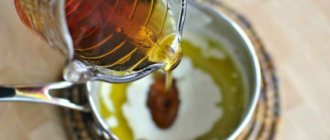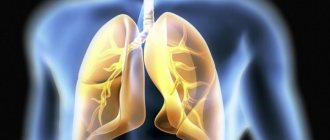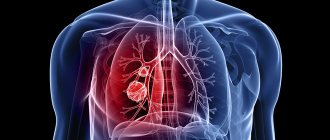Cough › In adults › How to treat cough with sputum without fever in an adult
When an adult does not have a cough with sputum without fever, this condition may indicate serious damage to the respiratory organs. This symptom is the body’s defense and occurs when foreign substances enter the respiratory system.
Often during a cold, a cough develops with phlegm, which comes out during the coughing process. Phlegm is a viscous mucus produced by the mucous membrane. Sputum consists of water with glycoproteins, immunoglobulins and lipids. In accordance with their concentration in the composition, the mucus acquires its own shade - from light yellow to brown. When coughing with sputum, pathogenic microorganisms and toxins that cause the disease and its complications are removed.
Wet cough in infants and pregnant women
I all know that a cough can be wet or dry.
However, not everyone distinguishes them from each other. A wet cough sounds bubbling, gurgling and comes from inside the chest, while a dry cough is throaty, paroxysmal, whistling. Most often, a wet cough brings relief. But sometimes it is, like dry, unproductive and painful. Much depends on the viscosity of the sputum. If it is thick and sticky, then it is difficult to cough it up. A wet cough is one in which excess mucus is produced. Sputum is mucus produced by the cells of the bronchial mucosa. Normally, it is always present in the respiratory tract in small quantities. This is necessary in order to prevent the penetration of foreign substances or microorganisms further into the respiratory tract. A person coughs up sputum containing pathogens, and his bronchi are cleared.
Treatment of cough with sputum in infants has its own characteristics. Expectorant medications are not prescribed for up to six months, and mucolytics are used with great caution. In order for the baby to clear his throat better, it is recommended to often change the position of his body and carry it on his arms in a column. Particular attention should be paid to the humidity in the room and ensure that the baby has enough fluids. All medications are given to children under one year of age in the form of drops or suspensions.
Pregnancy is not an obstacle to drug treatment of cough. A wet productive cough is considered not as dangerous as a dry cough. However, you should not let the disease take its course either. There are many drugs that do not affect the fetus. To thin sputum, it is allowed to take Mucaltin, Plantain syrup, Stodal.
Effective treatment for wet cough
When a person suffers from a wet cough, he will need to ensure the correct drinking regime simultaneously with drug therapy, where the composition of the tablets is predominantly natural.
The basis of such remedies are medicinal herbs that promote expectoration of mucus, relieve inflammation and bronchial spasms, making breathing easier. In addition, the medicine should alleviate irritation of the mucous membrane.
In the absence of special contraindications, inhalations with saline or soda can be used in treatment. Such procedures with the addition of herbal ingredients are very useful.
During inhalation, the sputum is liquefied, the mucous surface is moistened and softened, and the cough gradually recedes. At the same time, these remedies will help relieve pain as it develops and fight microbes that provoke the disease.
If cough is being treated in people with central nervous system pathologies, it is prohibited to use medications containing ipecac and thermopsis. For such patients, they can only increase coughing, which even leads to vomiting, and sometimes a state of suffocation occurs from lack of oxygen.
The following medications are used for wet cough without fever:
- Expectorants that thin mucus and facilitate the removal of sputum during coughing.
- Drugs that help return sputum to normal concentration. After which she begins to expectorate correctly and the cough with sputum without fever goes away faster.
In an adult, treatment with mucolytics will greatly help in regulating the viscosity of sputum. For asthmatic wet cough, the use of certain mucolytics is prohibited, because they can cause great harm to the patient's health. Before choosing and purchasing a medicine, consult a doctor.
- In order to stabilize the secretion of mucus by the bronchi and accelerate the removal of this mucus, mucolytics are also used. The most famous medicine in this group is ACC.
Causes of severe cough with phlegm
The causes of a wet cough include various colds and respiratory diseases. Also, a wet cough can appear as a result of such serious diseases as chronic bronchitis, pneumonia, asthma, tuberculosis, etc.
With tracheitis or bronchitis, there will be copious amounts of sputum when coughing. When the mucus you cough up is rusty in color, it may be the beginning of a developing pneumonia. With tuberculosis, bloody, red streaks may be present in the mucus. In bronchial asthma, the sputum discharge is viscous and glassy. Sputum with pus and an unpleasant odor occurs with bronchiectasis or an abscess. Therefore, this should never be ignored.
A wet cough can be caused by a variety of diseases. The most common cause is acute respiratory infections, in which productive coughing is a good sign and indicates a speedy recovery. However, do not discount other possible options.
1. Infectious disease. A cough with sputum is accompanied by almost any respiratory tract infection, both mild and severe. It can mean acute respiratory infections, acute bronchitis, pneumonia, tuberculosis, as well as their complications.
2. Chronic bronchitis. A persistent cough with sputum production for 3 months or longer indicates that bronchitis has become chronic. Usually the symptom occurs immediately after waking up, when doing physical exercises, or intense breathing.
3. Allergic bronchitis. Allergy cough is paroxysmal, often accompanied by shortness of breath. The body temperature remains normal.
4. Sinusitis, rhinitis, tonsillitis and other diseases of the nose and throat. Often, when coughing, it is not the phlegm from the bronchi and lungs that begins to be coughed up, but the snot that affects the throat. Mucus drains down the back of the throat, causing soreness and coughing. In a horizontal position of the body, the symptoms intensify.
5. Smoker's cough. A person who smokes absorbs over 200 poisons along with tobacco smoke. Once in the respiratory tract, they irritate the mucous membrane, which causes increased sputum production. Harmful substances settle in the lungs, and after 2 years of smoking, 90% of smokers begin to suffer from a morning cough and the discharge of viscous sputum during the day.
6. Wet cough as a residual phenomenon. After the destruction of germs, viruses or other pathogens, the body still needs some time to recover. At first, the sputum that has accumulated during the illness is removed from the lungs. Epithelial cells and villi are renewed, mucus production gradually improves, and its volume decreases.
The sudden appearance of a sore throat, which is accompanied by a wet cough, is the main symptom indicating diseases in the upper respiratory tract - bronchi, lungs and trachea.
Inflammation of the bronchi
- viral respiratory infections;
- inflammation of the bronchi in obstructive form;
- inflammation processes in the lungs;
- allergies of various etiologies (bronchial asthma);
- abscess in the respiratory organs;
- chronic form of rhinitis;
- infection with Koch's bacillus (tuberculosis).
The attending physician can name the exact cause of the constant need to cough and discharge of mucus. To do this, it is necessary to undergo an examination to obtain an accurate diagnosis, but in some cases the disease can be recognized by the color and characteristics of the sputum.
Prolonged cough with sputum
A prolonged cough is one that lasts more than four weeks. However, there is no improvement. This condition is considered dangerous, because a cough of this nature indicates the presence of a serious disease. To cure the disease, the first thing you should do is see a doctor.
Based on the complaints, he will prescribe an examination, which includes radiography. This is necessary in order to confirm or deny the presence of lung cancer. A heavy cough with sputum of a long nature can also occur in a heavy smoker, and also signal the presence of bronchial asthma and tuberculosis.
Cough with phlegm can occur in people who constantly work with chemicals. Such professional activity can become dangerous for a person, so it is recommended to change your occupation.
Appearance mechanism
A wet cough almost always develops from a dry cough. Sometimes the transition happens very quickly and takes about 2-3 hours. But on average, sputum begins to appear on days 2–4 of a dry cough. The mechanism of the appearance of a wet cough has several successive stages.
1. Inflammation of the upper respiratory tract. The mucous membrane is irritated by viruses, bacteria, allergens and becomes hypersensitive. Irritation, and as a result, an attack of dry cough is caused by any negative factor (dust, tobacco smoke), and even the flow of air during breathing.
2. Spread of inflammation to the trachea and bronchi. The cells of the bronchial mucosa begin to actively produce mucus to remove the irritating source.
3. Removal of sputum. Then the mucus, together with the foreign particles enclosed in it, is picked up by the villi of the ciliated epithelium and moves up to the pharynx. But often the villi die due to inflammation, and the cleansing of the bronchial tree is not so effective. And the difficult-to-remove secretion thickens and causes paroxysmal coughing.
An attack of wet cough can be triggered by a change in body position, physical activity, traveling in public transport, or frequent uneven breathing when talking. As a rule, it intensifies in cold weather, dry polluted air, and smoking.
Important. A child suffers a wet cough more severely than an adult. In childhood, the chest muscles are underdeveloped and the airways are narrow. Therefore, it is difficult to clear your throat. And the sputum itself in children is more viscous, which only aggravates the already poor discharge.
Folk recipes
A huge number of traditional medicine methods are known to stop a wet cough without fever. Lemon for coughs is an excellent remedy containing many vitamins. To prepare not only healthy, but also tasty medicine, you need to mix 150 g of honey and grated lemon. The medicine is taken one teaspoon before meals. You don’t need to melt honey for this; the main thing is to choose a lemon without bitterness.
A decoction of sage for cough contains essential oils, having a bactericidal and expectorant effect on the body. Sage also contains vitamins, phosphoric acid, and tannins, so it is simply irreplaceable for colds with a strong wet cough.
Onions with honey have long established themselves as one of the most effective traditional medicines. To prepare you will need half a kilo of peeled chopped onion, 2 cups of sugar. The mixture is boiled in 1 liter of water for 3 hours. Then cool, mix with 2 tablespoons of honey. You need to take the medicine after meals, 2 tablespoons at a time.
Symptoms
A wet cough occurs together with the following symptoms:
- Sometimes the body temperature rises to thirty-eight degrees or higher.
- Painful attacks of coughing at night.
- The sputum comes out with mucus.
- Pain in the shoulder blades and chest.
- The appearance of wheezing.
- Shortness of breath for no apparent reason.
- There may be loss of appetite.
Types of sputum discharge during a wet cough
What is sputum?
Sputum consists of the secretion of the glands of the large bronchi and trachea, mucus from the sinuses and saliva of the oral cavity.
It is considered a pathological secretion, and its careful examination can tell a lot about the disease that caused its secretion. Mucus from the glands of large bronchi and trachea is produced in an amount of 100 ml. This liquid is swallowed and evaporates during breathing. Tracheobronchial secretion not only moistens the mucous membrane of the respiratory tract, but also has a cleansing effect. It is able to destroy pathogenic microbes and remove foreign particles from the respiratory tract.
What type of sputum is there?
Sputum is mucus, a secretion produced by the bronchial epithelium. With the help of villi of the mucous membrane of the respiratory tract, it moves to the pharynx, where it mixes with saliva and nasal discharge. Normally, sputum is transparent, liquid in consistency and is released in small quantities, completely imperceptible to humans. It consists of salts, water and immune system cells.
When foreign particles enter the lower respiratory tract, the volume, viscosity and color of mucus changes. Let's figure out what its appearance means.
1. A clear, abundant secretion indicates the immune system is fighting viruses, allergens or toxins. Usually it is liquid and has a salty taste. Associated symptoms are often observed: lacrimation, runny nose, rash on the body, sneezing.
2. White sputum is a sign of inflammation of the respiratory mucosa. The mucus acquires this color as a result of swelling, which prevents its passage through the respiratory tract. It often has a viscous consistency and is difficult to cough up.
3. Yellow color of sputum is a symptom of infection (usually bacterial) in the respiratory tract. Yellowness is given by leukocytes and cells of the immune system, which arrive at the site of inflammation and die in attempts to neutralize it.
4. Green mucus indicates the same infection, but with a more extensive and stronger immune response. Sputum acquires this color due to the high content of bacteria, leukocytes and immune cells neutrophils containing green protein.
5. Brown color comes from dried blood. The cause of bleeding may be hidden in the rupture of small vessels. Sometimes such a symptom indicates severe inflammation of the bronchi or lungs. In addition, smokers may cough up brown mucus. Tar and particulate matter from cigarettes not only cause mucus to be coughed up, but also color it tobacco-colored. The mucus will be brown if a person drank red wine, coffee and chocolate before coughing.
6. Red sputum when coughing is a symptom of bleeding. Hemoptysis is typical for tuberculosis, pneumonia, cancer, and pulmonary embolism.
7. Pink sputum with difficulty breathing, chest pain and increased sweating may indicate pulmonary edema or acute heart failure. The patient requires urgent medical attention.
8. Gray color and foamy mucus are signs of chronic obstructive pulmonary disease. Air bubbles mean that there is not enough oxygen entering the blood, and acute respiratory failure can develop at any time.
9. A blood streak in the sputum indicates damage to a vessel in the respiratory tract. This often happens if a person has been sick for a long time, has diseases of the cardiovascular system, or his mucous membranes dry out (dry air in the room).
Changes in the color and consistency of sputum can provoke not only infectious diseases. Mucus becomes viscous when dehydrated, in the morning during sleep, if a person is under severe stress. Some drinks and food and polluted air can give a specific color. Only a laboratory assistant can make a correct assessment of the secretion. To do this, you need to pass a general sputum test.
How to treat and what to do?
People who have ever encountered a cough have wondered how to cure it. To get rid of it, you need to find out the cause. But with any cough, it can be cured or partially mitigated by the following actions:
- It is necessary to constantly moisten the room. Dry air prevents mucus from coming out, so mucus accumulates inside the bronchi. With the help of moist air you can quickly cure a cold. A dry cough is much easier to tolerate in a humid room.
- Drinking plenty of fluid helps thin the mucus and remove it.
- Stop smoking.
- Traditional methods of disposal. Inhalations and herbal steam baths have a beneficial effect on the respiratory system and mucous membrane. The question of how to treat a cough disappears if you take antibiotics when it is a common cold.
It is more difficult to treat a wet cough than a dry cough. It is for this reason that many people wonder how to treat a wet cough. Treatment of the wet type is directly related to the causes of its occurrence. A wet cough can easily infect another person through the secreted sputum, which contains germs and other foreign bodies. If it is not strong and was formed as a result of colds, then it can be completely cured at home. Very often it is formed due to the presence of microbes in the human body. You can get rid of it using a salt solution. The solution should be dripped into the nose, 2-3 drops per day. During colds, physiotherapy can be used. It is carried out using warming ointments and steam baths. During treatment of wet type of pathology, it is necessary to observe bed rest. If the cough raises suspicions of other diseases, then it is necessary to urgently consult a specialist, and the attending physician will prescribe medication.
In order to cure a cough with sputum, it is necessary to find out the true cause of its occurrence. To do this, they are examined and tested; only after all the procedures have been completed, treatment is prescribed. During treatment, first of all, they try to remove mucus and get rid of cough. Doctors prescribe special expectorants or sputum thinners.
Why is it dangerous?
In acute bronchitis, the patient suffers from a nonproductive (dry) cough for 2-3 days. But if you follow a drinking regime, take mucolytics and other drugs, the mucus thins out and is therefore easily excreted.
If you don't cough up sputum well, it accumulates in the lungs. It contains saccharides and protein substances, which are a substrate for pathogenic microorganisms.
Untimely treatment of cough with difficult to separate sputum is fraught with:
- pneumonia;
- chronic bronchitis;
- respiratory failure.
To prevent complications, therapy begins at the first signs of bronchitis or other ENT diseases.
A wet cough is usually productive and easier to tolerate. It is considered to be less dangerous than dry. But this only applies to those cases when the basis of the sputum is mucous, and it itself is colorless or white. Other species indicate health hazards. It is necessary to consult a doctor, there is a secretion that can be coughed up:
- purulent (has a yellow-green color);
- mucopurulent;
- serous (sticky, yellow or brown);
- bloody.
Such sputum is formed in acute diseases of the respiratory tract and some diseases of the cardiovascular system. An accurate diagnosis can be made on the basis of a comprehensive study: X-ray of the lungs, general analysis of blood, urine, sputum, questioning, auscultation (listening with a stethoscope).
Expectorants
It is impossible to quickly treat wet cough without expectorants. First of all, these are medicines based on marshmallow: Mucaltin, Alteyka syrup and marshmallow root. These drugs are necessary for the treatment of acute and chronic forms of diseases of the respiratory system, such as bronchitis, tracheobronchitis, and pulmonary emphysema.
The products work well even with high viscosity of sputum. They thin out its consistency, stop the inflammatory process, stimulate contraction of the bronchial walls - together, this makes it possible to remove pathogenic mucus faster and easier.
Preparations based on Althea are contraindicated for the treatment of patients with individual intolerance to the drug, or with stomach and duodenal ulcers. You also need to be careful when treating a diabetic with this medicine.
Another group of expectorants are medications based on thermopsis. They help in treating the symptoms of colds by irritating the respiratory center, thereby provoking the release of phlegm. This group of drugs includes Codelac, Thermopsol. They also stop inflammation thanks to additional active components in the composition.
Expectorant teas containing oregano, plantain, licorice, anise, sage, wild rosemary, calendula, etc. help quickly treat a wet cough. An effective remedy based on medicinal herbs is the Bronchofit elixir.
Cough treatment
First of all, you need to know the cause of the cough. If you don't know her, you should consult a therapist.
Price from 150 rub.
- These are various antitussive and mucolytic drugs. Namely: Mukosol, Mukobene, Ambrolan, ACC;
- Syrups are also used that dilute mucus and remove it. Lazolvan, Ambrobene and others;
- There are a number of expectorant medications that can help you fight your cough. Tablets Travisil, Mucaltin, Stoptussin. Syrups Bronchicum, Amtersol;
- The most gentle method of dealing with wet cough is inhalation. When inhaling medicinal steam, expectoration is stimulated and mucus is liquefied. There is an inhalation device called a Nebulizer. You can use it to treat a wet cough at home. The nebulizer directs a steam flow to the respiratory organs, which contributes to their treatment. The patient can adjust the duration of the procedure as needed;
- If the cough is caused by pneumonia or bronchitis, the doctor will prescribe antibiotics.
From time immemorial, people who were completely unaware of various chemical medications used herbs, tinctures, compresses and other useful remedies. And this treatment was quite effective and efficient.
- Chop a large onion and add sugar to the crushed mass to get a thick consistency. Squeeze everything through cheesecloth. The resulting syrup should be taken one tablespoon three times a day.
- The top of a medium-sized radish is cut off and a recess is made inside the root crop. Then any natural liquid honey is poured into the hole made. Cover the whole thing with the top of the radish, which you first cut off, and leave for a day. When the medicine is infused, you should take it three tablespoons a day an hour before meals.
- Pour two tablespoons of dried calendula flowers into 200 ml of boiling water. Cover with a lid, wrap with a thick cloth and let sit for half an hour. Take the decoction three times a day, two tablespoons before meals.
- Finely chop a few cloves of garlic, add milk and boil for five minutes. Drink a tablespoon three to four times a day.
- A very good remedy for treating coughs is badger fat, which is melted in a water bath and consumed, mixed with a spoon of honey, on an empty stomach.
- Boil two grated onions in a glass of milk. Infuse the broth for three hours and strain. Take one tablespoon every three hours.
- A real helper for a wet cough will be goat's milk, which you should drink warm, in small sips of 200 ml, three times a day. By enveloping the inflamed mucous membrane, it reduces cough. Goat's milk has long been known as a remedy for coughs and colds.
- Add half a teaspoon of soda, one teaspoon of honey and a little butter to a glass of warm milk. You need to drink half a glass in small sips twice a day.
- Mix equal parts honey with viburnum berries, which you previously boil for five minutes and rub through a sieve. Take the resulting medicinal composition one teaspoon before meals.
- For a wet cough, drinking raspberry tea is very useful. Moreover, not only from berries. Its leaves, stems and roots can become assistants in the treatment of this disease. Raspberry decoctions will remove phlegm and soften the mucous membrane.
Only a doctor can tell you how to quickly cure a cough, because he will make a diagnosis based on the diagnosis of sputum. It is released during pathological processes in the respiratory tract or organs, becomes noticeable and causes discomfort. A cough with sputum is called wet, and without it - dry. If a person chronically suffers from cough syndrome, he is constantly ill; in the absence of such an effect, the nature of the disease is periodic.
According to the type of cough development, it can be acute or chronic. Acute lasts up to 3 weeks and is associated with acute respiratory infections, acute respiratory viral infections, infectious and allergic diseases. Lingering or chronic is observed in the mornings in smokers and occurs due to nervous diseases, heart or lung. Different types need to be treated differently:
- for wet expectorants that remove phlegm are suitable;
- for dry – mucolytic;
- for long-term, fast-acting antibiotics.
A wet cough may go away on its own if it is residual. However, even in this case, it is important to exclude sputum stagnation and thickening. Difficult discharge leads to the accumulation of mucus, which, in turn, serves as an excellent breeding ground for microbes. Walking in the fresh air and drinking plenty of fluids can help relieve thick mucus.
In the acute period of the disease, treatment is carried out with medications. For coughs with phlegm, the following types of medications may be prescribed.
1. Mucolytic tablets and syrups. They thin out mucus and help it leave the lungs faster. At the same time, the mucus practically does not increase in volume. Prescribed for bronchitis (acute, chronic), pneumonia, tracheitis, cystic fibrosis. Representatives of the group: Ambroxol, Lazolvan, Bromhexine, Mucaltin.
2. Expectorants. They have an irritating effect on the mucous membrane. Having taken such a drug, a person begins to cough reflexively, and his respiratory tract is cleared of phlegm. As a side effect, expectorant tablets increase mucus secretion. Examples: Licorice root syrup, Thermopsis tablets, Eucalyptus and Terpene essential oils.
3. Mucoregulators. They have the ability to increase the amount of surfactant - surface-active substances that line the inside of the alveoli of the lungs and prevent the walls from sticking together during breathing. A medicine with a mucoregulating effect does not simply dilute sputum, but also equalizes the content of the liquid and mucous parts. Names: Ascoril, Ambroxol, Bromhexine.
Attention! Expectorants should not be taken in the evening. They provoke a cough for the next 5–6 hours. A child or adult risks not sleeping all night. It is correct to take them according to the instructions before 17–18 hours. Then the sputum will be removed effectively and without disturbing sleep.
Wet coughs need to be treated in a comprehensive manner. Depending on the cause of it, other drugs are also prescribed:
- antibiotics to treat a bacterial infection;
- antihistamine tablets against allergic cough;
- antiviral drugs for bronchitis of viral origin;
- antipyretic tablets and syrups, if there is a fever (they also have an anti-inflammatory effect).
Electrophoresis with calcium chloride and inhalation of saline solution also have the property of improving sputum discharge. However, they can only be used in the absence of fever. If there is no fever, the teenager and adult can apply warm compresses and ointments to the chest. It is better to rub small children with fat (badger, duck).
Advice. People who constantly suffer from a wet cough or have chronic respiratory diseases are recommended to purchase a home nebulizer. The device helps deliver medications directly to the source of infection, bypassing the gastrointestinal tract.
Causes of wet cough without fever
A wet cough helps the body on the path to recovery, because excess mucus and foreign components that clog it are rejected from the respiratory system. This allows for faster recovery.
Sputum is a secret that is actively produced during the development of inflammation of the respiratory organs or when infections of various origins penetrate into them.
The process of removing mucus may be normal, because the human respiratory system produces it without stopping (for example, the morning cough of smokers).
But sometimes sputum indicates a serious pathology in the body. When a person begins to cough and does not have a fever, the causes of this condition may vary, but the main source is diagnosed by a doctor.
A wet cough without fever can be provoked by:
- Hypersensitivity to environmental allergens.
- Violations of the functioning of blood vessels and cardiac activity, for example, with heart failure.
- The presence of foreign particles in the hollow organs that conduct oxygen to the alveoli of the lungs.
- The influence on the walls of the respiratory trunk of toxins that enter from the external environment during inhalation.
- Venereal pathologies.
- Harmful addictions – smoking. With the help of coughing, the lungs try to clear themselves of nicotine tar from cigarettes, which settles just on the mucous membrane of the respiratory system.
Also, a wet cough without fever can accompany acute or chronic respiratory pathologies of various origins, for example:
- Bronchiectatic diseases.
- Edema in the lungs.
- Pneumonia.
- Bronchitis and tracheitis.
- Sinusitis.
- Pulmonary abscess.
- Tuberculosis.
- Bronchial asthma.
- The development of a wet cough immediately after sleep in the morning and at night during sleep can be provoked by the bites of bed mites, which most often infest feather pillows.
- Oncology in the lungs.
- Pulmonary infarction.
Prevention measures
To take preventive measures, you need to follow a few tips to maintain a healthy lifestyle:
- Elimination of bad habits.
- Ventilate residential premises on a regular basis.
- The use of vitamins and immunomodulators.
- Eating fresh vegetables and fruits.
- Maintaining a correct daily routine.
It is much easier to cure a cough with sputum in a timely manner than to allow complications to arise, which will not be easy to get rid of.
- First of all, strengthen your immunity, because a wet cough is a symptom of the disease.
- Walk in the fresh air for at least half an hour a day.
- Contrast shower, dousing with cold water, hardening.
- During the cold period, humidify the air in the room.
- To maintain immunity, especially in winter, you need to take a course of vitamins.
- During ARVI epidemics, avoid places where large numbers of people gather. Get a flu vaccine if necessary.
- Try to avoid hypothermia.
How to classify?
By the color, smell of sputum and the amount of its secretion, you can determine the cause of its occurrence.
And by the sound of coughing you can recognize the symptoms of the disease. Kinds:
- Physiological is a normal phenomenon that is even necessary for a healthy person. The necessary physiological and periodic syndrome is needed to cleanse the respiratory system of foreign bodies accumulated inside. This cough makes itself felt mainly in the morning. Healthy children can cough up to 10 times a day, this is necessary to free the bronchi from accumulated mucus.
- Pathological – makes itself known when various diseases occur against the background of inflammation of the respiratory system.
- Dry - occurs with dyskinesia of the trachea and bronchi. In this case, diseases such as pneumonia, cancer, tuberculosis, etc. can be identified.
- Wet (wet) - phlegm is produced, this happens when fluid accumulates in the body in the form of blood, pus or other mucus. It can be treated only after the body has rid itself of accumulated fluid. A wet cough is a sign of bronchitis or pneumonia.
- Time-based – morning, evening, night (occurs only in smokers).
- Permanent – occurs due to chronic diseases.
conclusions
A wet cough as a symptom of the disease can be cured with both medication and folk remedies. It is important to first find the cause, the disease that caused this unpleasant symptom. Only the attending physician can accurately determine the diagnosis and prescribe treatment. The exact dosages of the medications are written on the packaging, and the doctor determines the dosage regimen individually.
Traditional cough recipes will never be superfluous and will only alleviate the patient’s condition. And if the cause of a wet cough is not a serious illness for which antibiotics need to be used, then more often treatment with traditional methods can completely cure the disease. Remember that if you have a wet cough, bed rest is not recommended!
Morning cough
Very often there are situations when people cough when waking up. In fact, this is a normal phenomenon, since this clears the airways. But a coughing person should be aware that normally the amount of sputum is small and its color is transparent. If a morning cough with green sputum appears, then this is not the norm.
Coughing in the morning is most common among smokers. It is also characteristic of chronic pathologies of the upper respiratory tract.
Associated symptoms
Cough is almost never observed as an isolated symptom. As a rule, it is accompanied by additional manifestations, which crown the clinical picture of the disease.
What complex of signs is usually characteristic:
- Dyspnea. Increasing the number of breathing movements per minute. The most common manifestation, which indicates a developed process on the part of organs and structures.
- Suffocation. It is caused by a narrowing (obstruction) of the lumen of the bronchi. Provokes respiratory failure and the inability of adequate gas exchange. This is dangerous because it can be fatal. The intensity of suffocation varies and depends on the nature of the underlying pathological process.
- Tachycardia. Increased heart rate above 90 beats per minute. Almost always observed.
- Hyperthermia. It is noted in some cases as a consequence of an infectious-inflammatory lesion. In the complex, general manifestations of intoxication of the body are additionally observed in the form of headache and general weakness of the patient.
- Hemoptysis. Most typical for intense cough, tuberculosis and cancer of the respiratory system.
In all cases, careful diagnosis is required. Based on the symptoms described, it is not so easy to determine the probable disease. A number of objective studies are required.
In some cases, an urgent call to the doctor is required:
- This is necessary if the patient’s high fever does not subside for three days or more, he refuses to eat, and excessive sweating is observed.
- The cough occurs suddenly and lasts for fifteen minutes or longer, while the person has difficulty coughing up.
- Sputum is separated, but it is uncharacteristically colored and purulent or bloody discharge is visible to the naked eye.
Main reasons
The sputum released during coughing is a kind of secretion produced by the mucous membranes. It consists of specific protein inclusions, as well as salts and water.
In its normal state, the secretion should be transparent in color and liquid in consistency. However, the cough may be pathological, the color of the sputum changes, and the same applies to consistency.
The most likely reasons why a cough with sputum without fever occurs:
- Allergy. The body tries in every possible way to protect itself from the allergen, which is why it produces a large amount of sputum. In this case, there may be snot, tears, and the larynx swells.
- Cardiac cough - occurs immediately before an attack. Cough occurs due to lack of oxygen.
- Presence of a foreign body. Once small particles enter the respiratory tract, they linger there. The secretion secreted by the mucous membranes helps relieve irritation; it feels as if it is trying to push something out.
- Toxic substances. When a person is in a room where there is a lot of smoke or other harmful substances, a cough occurs, and during this period it is a kind of defensive reaction. There are no asthma attacks or bronchospasms.
- The development of sexually transmitted diseases - syphilis, AIDS, etc. With a sharp decrease in immunity, a wet cough is constantly bothering you, but your temperature is normal.
- Abuse of bad habits, namely smoking. Heavy smokers suffer from a wet cough, especially in the morning.
- Chronic diseases, such as tuberculosis. The temperature can rise only in the first stages of the development of the pathology; during remission it is absent.
As you can see, there are quite a few reasons why coughing with phlegm appears. In order to make an accurate diagnosis, you should contact a medical facility.
External reasons
Many external irritants, as well as an allergic reaction, can provoke a cough with phlegm. It can occur on many food products, hair dyes, cosmetics, etc. You should remember what products you have used recently; perhaps they were the cause of the cough.
The apartment should be thoroughly cleaned, but the use of household chemicals is not recommended. Remove all smelly objects from the room you are in, wipe off the dust, and make sure there is no mold anywhere.
Mold spores can cause a dry cough, but if allergies also appear, the amount of sputum will increase sharply.
A wet cough, without hyperthermia and worsening in the morning, can be caused by a tick living in the bed. In this case, the bed linen should be replaced, old pillows and feather beds should be thrown away.
Physiotherapeutic treatments
A wet cough without fever can be treated with many physiotherapy procedures, for example, inhalations, warming and others.
The following help best:
- Inhalations.
Coniferous essential oils, sage decoction, soda solution, etc. can be used for them. The number of procedures per day is no more than two, their duration is 10-15 minutes. To treat bronchopulmonary diseases, it is effective to use an ultrasonic inhaler; pharmaceutical solutions are added to it.
- Paraffin therapy.
During the procedure, the bronchi and lungs are warmed up, since paraffin is the best way to conserve heat. Breathing becomes easier, blood circulation improves, the bronchi expand, and mucus can be released quickly and completely. A compress is applied every other day, the places for this are the chest and back. The heart area should be avoided - this is important. It is recommended to carry out the procedures before bedtime, as after them calmness is shown.
- Electrophoresis is not only heating, but also treatment.
Under the influence of electrodes, drugs penetrate the skin, thus significantly accelerating the healing process. An individual current strength is set for each patient. The procedure lasts no more than ten minutes. The recommended course of treatment is ten sessions, carried out every other day.
- UHF.
An ultrasound therapy device can provide complete heating. The procedure is especially effective for bronchitis and pneumonia. The patient practically does not feel the physical effects of bronchitis. The procedure lasts about ten minutes, after which you need to spend time in warmth and peace for half an hour.
- Warm baths.
In order to warm up the body, you can use baths with essential oils or decoctions of medicinal herbs. At the same time, you can achieve an inhalation effect; for this it is recommended to take a bath with pine branches, eucalyptus or sage oil. It is enough to add up to 20 drops of oil; when inhaled, they will enter the lungs.
If a wet cough occurs, it is recommended to gargle as often as possible; the mucus will thus be washed away.
Folk remedies
Thanks to traditional medicine, you can speed up the healing process and also effectively relieve disturbing symptoms. Inhalations, tinctures, decoctions, etc. can be used to treat cough.
The herbs presented below help remove phlegm from the body and liquefy it:
- oregano;
- licorice root, otherwise licorice;
- marshmallow officinalis.
When treating in this way, you should follow a few simple recommendations:
- When preparing medications, the dosage must be strictly observed. If the main ingredient is not enough, the finished product will not be effective. If there is an excess, there is a chance of turning the medicine into poison.
- You can use tinctures and expectorant decoctions no more than 4 times a day. Moreover, the last dose should be a maximum of an hour before bedtime.
- Herbal inhalations are carried out three times a day, the duration of each procedure is 15 minutes.
You can buy medicinal herbs in pharmacies. In the summer, you can collect them yourself, after which they are dried and crushed to prepare collections.
Recipes for preparing products internally
Tincture of a medicine based on licorice root:
- pour a spoonful of crushed root into a glass of hot water;
- simmer in a water bath for half an hour;
- let sit for ten minutes.
Add clean water to the resulting product, the result should be a glass of medicine. Divide into four doses and drink throughout the day.
Another healthy recipe includes milk and sage. You can prepare it as follows:
- dry the greens, pour ten grams with 0.3 liters of boiling water;
- let it brew for half an hour, then strain;
- Dilute the finished mixture with a glass of warm milk.
The resulting tincture must be divided into three parts and drunk throughout the day. Pregnant women and nursing mothers should not be treated in this way.
Diagnostics
Diagnosis requires a careful approach. The main specialized specialist is a pulmonologist. If gastritis or reflux esophgitis occurs, an additional examination by a gastroenterologist is required.
At the initial appointment, the doctor interviews the patient, assesses the nature of the complaints, their age and duration. A thorough initial inspection is required. Additionally, anamnesis is collected. It is important to identify all pulmonary diseases that are currently occurring or have occurred in the past.
In the future, specialized studies will not be necessary; they will allow us to verify the diagnosis and determine the selection of therapeutic tactics:
- X-ray of the chest organs. This is the first and most common diagnostic method. Allows you to identify all changes in the bronchi and pulmonary structures. Despite its simplicity and accessibility, it is not always possible to identify the source of the problem in this way.
- Bronchoscopy. Prescribed in all doubtful cases, especially in bronchiectasis and chronic obstructive pulmonary disease. In the first case, the bronchoscopic technique also has a therapeutic meaning, since it requires washing the bronchi with specialized solutions.
- Computer and magnetic resonance imaging. They are the most informative because they provide accurate results and detailed images of bronchopulmonary structures. In all cases, this is a kind of gold standard in diagnostics.
- General blood analysis. Sometimes it gives a classic picture of the inflammatory process with an increase in the number of leukocytes.
Taken together, these studies are quite sufficient to verify the diagnosis. Probably, in a particular case, a smaller number is sufficient, depending on the nature of the process and its complexity.
Treatment of wet cough: different types of discharge and their origin
There are certain pathological conditions and diseases that cause convulsive spasms, in which a huge amount of sputum is produced in the respiratory organs. The main ones:
- Bronchitis, flu. Accompanied by attacks of reflex movements of the diaphragm with purulent greenish-yellow discharge, sometimes mixed with blood. Such diseases occur quite often and patients are interested in: how to cure a wet cough quickly? However, haste can lead to the fact that the disease that caused the symptom remains untreated and relapses will occur in the future.
- Lung abscess. Characterized by reflex spasms of the respiratory tract with yellowish-brown discharge.
- Pulmonary edema. With sharp convulsive exhalations, foamy sputum with blood is released.
- Pulmonary infarction. Accompanied by attacks of spastic exhalations with expectoration of a substance colored bright red.
- Lung cancer. With reflex convulsive movements of the diaphragm, mucus with bloody streaks is released. Treatment of a severe cough with phlegm in this case does not help completely eliminate the symptom, but it does bring some relief.
- Pneumonia. It is characterized by spasms of the diaphragm with the discharge of yellow or greenish sputum.
- Bronchial asthma. Accompanied by attacks of reflex exhalations and the release of clear and thick mucus.
- Various fungal pathologies. Characterized by spasmodic sobs with the discharge of white slippery lumps.
- When green sputum is released when coughing, treatment of the disease must take into account that pus has appeared in the respiratory organs, consisting of leukocytes and bacteria. Its abundant content may indicate a rupture of the abscess. Often this is a symptom of a parallel course of sinusitis or sinusitis.
Sometimes sputum can change color under the influence of certain foods eaten. To draw the right conclusions, you should observe her condition for some time.

